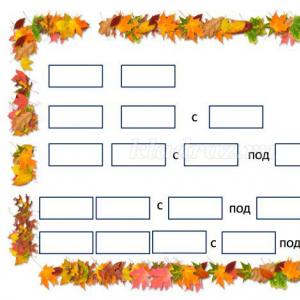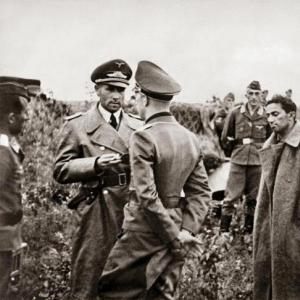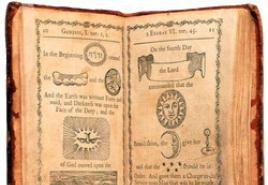History of puzzles for children summary. History of puzzles
The main thing when solving puzzles is to figure out exactly how to name the image in the picture (for example, a hedgehog and a hedgehog, one and a unit - the meaning is the same, but when replacing one word with another, the rebus "will not give in").
You can guess the whole sentence, or maybe you will come across only one word - anyway, the rebus does not contain any spaces or any semantic punctuation marks, and this is very important to consider when trying to "read" the drawings: one image may turn out to be not only the end of some word, but also the beginning of the next.
If a number and a letter with an equal sign between them are shown under the picture, you need to count the letter in the deciphered word, the serial number of which in the word indicates the number, and replace it with a letter from equality.
If there are images, letters or numbers of noticeably different sizes nearby (one is smaller), then they need to be read by adding the prepositions "U" or "at" before or between the words.
It happens that under the picture there is a list of numbers, then it is in this order that the name of the depicted object should be “read” letter by letter.
If there is an index arrow next to numbers, letters or figures, as if showing the direction of their movement, then you need to “see” the preposition “from” or “to” between them.
Puzzles for children
They are not difficult at all, and I hope the kids will be interested in them. Difficulties arise - review the rules again.
However, if adults join in solving them, they will only win: they will once again practice how to do it, and make sure that they have the skills.
Puzzles for adults (including smart adult children)
Since any work must have a logical conclusion, then all the puzzles presented here are with answers.
Answers to puzzles for adults and children
Answers to puzzles for adults and children, which are interesting and incredibly useful for any opportunity to exercise your mind, as well as solving any other logical problems. I call in the same order in which the puzzles with pictures that you recently had were located on the page, I want to believe, with pleasure, to solve.
The very first rebus in the article, intended for children, is at the very beginning of the article. I hope that it was also successfully solved by you, like all the others, divided into categories.
So, the first answer to the rebus is that the word "schoolboy" is encrypted in the picture.
Answers to the rest of the puzzles for children:
1. Mobile.
2. Bunny.
Answers to puzzles for adults:
1. Stimulation.
2. We solve problems.
3. Brain development.
4. Exercise your brain.
5. Intellectual level.
MBOU "Sugut secondary school"
REBUSES
MATHEMATICS
Completed by: 7th grade student
Lukyanov V.S.
Head: Lukyanova N.F.
With. Suguty - 2011
Relevance of the topic
Of great interest to students are games in the learning process. With the help of the game, abilities are tested and developed, students compete with each other.
The material covered in the lessons can be consolidated with the help of games. Compiling and guessing puzzles makes it easy to remember the correct spelling of mathematical terms, as well as better comprehend this concept.
It captivates the solution of the cognitive task contained in the rebus.
Problem
Mathematics has always been considered a difficult subject to grasp. Some students find it difficult to remember the rules of definition and formulas.
The ability of students to memorize educational material is very different.
Compiling and solving puzzles in the study of mathematics allows students to develop attention, observation, logical and creative thinking, and make the learning process more interesting.
Target:
To teach students to compose and solve puzzles with mathematical themes.
Introduction
History of puzzles.
What does the word rebus mean?
Rules for compiling and solving puzzles
Self-composed math puzzles.
Conclusion
Bibliography
History of puzzles.
The first puzzles appeared in France in the 15th century.
Rebus called a riddle consisting of images of various objects (often interspersed with letters, numbers and musical notes), the names of which do not denote concepts expressed by the words to be solved, but are similar to them in pronunciation or consonance (without any relation to spelling).
For example, depicted in puzzleshorse , tea , braid , roses are read: run out frosts ; forehead , zeros - burst andT. P..
The first known handwritten collections of puzzles date back to the end of the 15th or the beginning of the 16th century.
In 1582, their first printed collection appeared under the title "Les Bigarurres du Seigneur des Accords", which was a great success and went through several editions.
His book is a treatise on puzzles, but there are no more than 16 drawings in it.
Most of the rest of the puzzles Taburo conveys in the form of humorous stories.
From France fashion puzzles moved to England, Germany and Italy, but in none of these countries was it widely developed.
In Russia, he appeared in 1845 in the magazine "Illustration". Rebuses were painted even by famous artists like M.P. Klodt,
H. H. Karamzin; rebuses are considered especially successful
I. I. Volkova (in "Niva").
Millions of people in all parts of the world love to solve puzzles. And this is not surprising. “Mind gymnastics” is useful at any age. After all, puzzles train memory, sharpen intelligence, develop perseverance, the ability to think logically, analyze and compare.
Our ancestors knew chess and checkers, puzzles and riddles were not alien to them. Such games at all times were not alienated by scientists, thinkers, teachers. They created them.
Rebus is one of the most popular and widespread games. In the rebus, you can encrypt proverbs, sayings, excerpts from poems, individual phrases and words.
Rebus - a riddle in which the desired word or phrase
depicted by a combination of figures of letters or signs "
S. I. Ozhegov
Encyclopedic Dictionary of Brockhaus and Efron
←
back forward→
A rebus is a puzzle in which words, phrases and even short stories are hidden.
The word "rebus" comes from the Latin word "res" - "thing".
The essence of the rebus- a riddle formulated in the form of a picture (or photograph) in combination with letters, numbers, signs, symbols, figures.
Solve the rebus- means to “translate” everything that it contains into letters that make up a meaningful word or sentence.
General provisions
A rebus guesses a word or sentence (usually a proverb, saying, aphorism, quote).
The number of individual elements included in the rebus (drawings or photographs, as well as letters, numbers, signs, symbols, figures, and so on) is not limited.
To compose the rebus, special techniques are used that distinguish it from any other “riddle in pictures”.
These techniques can be used both independently and in various combinations (combinations) with each other.
The number of techniques used in one rebus and their combinations (combinations) is not limited.
Rebus Requirements
The rebus must have a solution, and, as a rule, one. The ambiguity of the answer should be specified in the conditions of the rebus. For example: "Find two solutions to this puzzle."
The guessed word or sentence should not contain spelling errors.
If one word is guessed in the rebus, then it should, as a rule, be a noun, moreover, in the singular and in the nominative case. A deviation from this rule must be specified in the terms of the rebus (for example: “Guess the participle”).
If a sentence is guessed (proverb, aphorism, etc.), then, naturally, it can contain not only nouns, but also verbs and other parts of speech. In this case, the conditions of the rebus should contain the appropriate phrase (for example: “Guess the proverb”).
The puzzle should be drawn from left to right.
|
Rules for solving puzzles The rules for solving puzzles are at the same time the rules for compiling them. a word or sentence is divided into such parts that can be depicted in the form of a picture; the names of all the objects shown in the figure should be read only in the nominative case; if the object in the picture is turned upside down, its name is read from right to left; if there are commas (one or more) to the left of the figure, then the first letters of the word are not read. If commas are after the figure, to the right of it, the last letters are not read; if a crossed-out letter is shown above the figure, it must be excluded from the name of the subject; if there are numbers above the figure, the letters should be read in the indicated order; if another letter is written next to the crossed out letter, it should be read instead of the crossed out one. Sometimes in this case an equal sign is placed between the letters; if part of the word is pronounced as a numeral, in the rebus it is represented by numbers and numbers (O5 - again; 100G - haystack); if the drawing does not have any additional characters, only the first letter of the name of the depicted object should be taken into account; many parts of encrypted words are indicated by the corresponding arrangement of letters and drawings. Words with combinations of letters on the, under, over, behind, can be depicted by placing letters or objects one above the other or behind the other. Letters WITH and V may become suggestions. If the letter is made up of other letters, the preposition is used when reading from. |
|
One of the main difficulties in solving puzzles is the ability to correctly name the object depicted in the figure and understand how the fragments of the picture relate to each other. In addition to knowing the rules, you also need ingenuity and logic. |
Conclusion.
When writing the work, I studied books on entertaining mathematics.
I learned that there are mathematical tricks that are based on the properties of numbers.
There are many puzzles that you can't solve right away. And this is their beauty.
But most of all I liked the puzzles.
People love not only to solve, but also to create puzzles, puzzles, tricks, every time they set themselves more and more new tasks, to study the wonderful world of mathematics.
My work can be used both in mathematics lessons and in extracurricular work on the subject. It will be of interest to students of all ages, as it allows you to usefully spend your free time, encourages search and creativity.
Literature:
1. Bereznev A.V. "Crosswords, games, riddles": Collection - Rostov-on-Don, 1998
2. Ozhegov S.I. “Dictionary of the Russian language”
3. Journal "Science and Life", 1992, No. 3
4. Magazine "Quantum", 1992, No. 2
Do you like to solve riddles? Then guess what it's about.
A riddle-joke in which a word or phrase is depicted in the form of drawings in combination with letters, numbers and other signs. Did you guess?
That's right, it's a puzzle. In our understanding, a rebus is a kind of riddle, where a word or even a phrase is presented in the form of pictures, symbols. It is believed that the word "rebus" itself was born from the Latin phrase "not with words, but with the help of things."
We meet in our life with puzzles often. Do you know the history of puzzles?
The history of puzzles began a very long time ago. In the 15th century in France, farcical performances were called a rebus. Later, in the 16th century, such fun was banned and a pun based on a play on words began to be called a rebus. Often it was a riddle, consisting of images of various objects, numbers or letters. And in this form, the puzzle has come down to us.
 In 1783, the English artist and engraver Thomas Buick printed an unusual Bible for children in the London printing house of T. Hodgson. He retells the events of Holy Scripture in the form of rebuses. Such a Bible came to be called "hieroglyphic". In the text, some words are replaced by pictures. A few years later, in 1788, the American publisher Isaiah Thomas published a hieroglyphic Bible overseas. Such unusual hieroglyphic Bibles became very popular at the end of the 18th century, as they made it easier and more interesting to teach the Holy Scriptures to children.
In 1783, the English artist and engraver Thomas Buick printed an unusual Bible for children in the London printing house of T. Hodgson. He retells the events of Holy Scripture in the form of rebuses. Such a Bible came to be called "hieroglyphic". In the text, some words are replaced by pictures. A few years later, in 1788, the American publisher Isaiah Thomas published a hieroglyphic Bible overseas. Such unusual hieroglyphic Bibles became very popular at the end of the 18th century, as they made it easier and more interesting to teach the Holy Scriptures to children.
The well-known author of "Alice in Wonderland" and "Through the Looking Glass" Lewis Carroll often used rebuses in his correspondence with young readers. In his letters, he often replaced some of the words with pictures or depicted letters in a mirror image. To read such mysterious letters, one needed ingenuity, which, of course, the children really liked.
In the second half of the 19th century, puzzles began to be widely used in society.
Interestingly, even during the war, puzzles were held in high esteem. During the Great Patriotic War, in 1942, the Moscow printing factory of the Moskvoretsky industrial trade publishes a collection of rebuses by A.A. Ryazanov "During Leisure Hours: Rebuses" (illustrations by I. Telyatnikov). They were intended for the adult population. In 1945, after the end of the war, a small brochure by the illustrator and illusionist Georgy Kelsievich Bedarev "Rebuses" was published.
In the post-war period, puzzles began to focus on a children's audience. Currently, puzzles are intended for both adults and children. It is difficult to find a children's magazine or a developmental manual that does not contain puzzles. Often children are given similar tasks at school and are even given the task to come up with puzzles.
Regardless of who the puzzles are intended for, the rules for guessing them are the same. In order to correctly guess the rebus, of course, you need to know these rules.
Try to solve a few puzzles, as well.
Rebuses on the history of the fatherland (collection)
Introduction
Rebus (from Latin rebus - “with the help of things”), the representation of a word or syllable by means of an image of an object, the name of which is consonant with the represented word or syllable. Several puzzles can be combined in one drawing or as a sequence of drawings in order to make up a phrase or sentence. In literary puzzles, letters, numbers, musical notes, or specially arranged words are used to compose sentences. Compound puzzles include pictures and letters. Puzzles can convey the direct meaning of words, mainly to inform or instruct illiterate people, or deliberately hide their meaning in order to inform only the initiated, or when used as a riddle and entertainment.
In Europe, literary puzzles could often be seen on generic mottos, personal seals, monograms, bookplates, and, finally, as entertainment or riddles. In England, a well-known rebus is the IOU. Picture riddles were widely used in advertising campaigns.
Historic motheral requires deep reflection, which is complex challenge for students special (correctional) school,because their thinking “is characterized by inertia; they are bad poniesmayut the educational material reported to them. Considering this specialmentality of mentally retarded children, the teacher shouldcarefully select the facts and phenomena reported to studentsand think well about the form of your presentation; only prea lucid, clear, simple story can be accessed students.
Students of a special (correctional) schoolcarry out the "transfer" of acquired knowledge to similar facts and events. The teacher should take this feature into account and helpstudents to establish the necessary connections and relationships betweenhistorical events.In order to develop thinking, it is advisable to returnto the same fact, historical term several times.
In this collection “Rebuses on the History of the Fatherland”, puzzles are proposed that may be of interest to teachers, educators of correctional schools, as well as teachers from educational schools.


















Conclusion
In this collection “Puzzles on the History of the Fatherland, Grade 8”, puzzles are proposed that can be used in history lessons, as an introduction to new terms, as well as to consolidate them. Students of a special (correctional) school are not good at “transferring” acquired knowledge to similar facts and phenomena. The teacher must take into account this feature, and help students to establish the necessary connections and relationships between historical events. In order to develop thinking, it is advisable to return to the same fact, historical term several times. Therefore, the use of puzzles in the classroom contributes to the development and correction of thinking, remembering historical dates and names.
As part of the educational and methodological set "History of the Fatherland, grade 8 for schools of type VIII", this collection of tests is an integral part of the set. All tests are presented in electronic form on a disk. Students can independently use them to test and consolidate knowledge, as well as by the teacher at any stage of the lesson.
Bibliography
1. Petrova, L. V. Methods of teaching history in a special (correctional) school of the VIII type [Text] / L. V. Petrova. – M.: Vlados, 2003. – 208 p.
2. Puzanov, B.P. History of Russia: textbook. for 8 cells. special (correctional) educational institutions of the VIII type [Text] / B. P. Puzanov. - M.: VLADOS, 2004. - 312 p.
3. Smirnova, A. N. Correctional and educational work of a secondary school teacher: a guide for teachers and educators [Text] / A. N. Smirnova. - M.: Enlightenment, 1992. - 104 p.
Where did the first puzzles appear?
The origin of the concept of "rebus" is associated with fifteen-century France. It was in this century that the word was first used, but not quite in the sense in which it is used in our time. In the fifteenth century, the word "rebus" meant humor, a playful entertainment show presented at the carnival. The main theme of such shows was topical issues that concern the entire population of the country. The jokes had to be sharp and precise.
Some time passed, and they began to name completely different things. The same French began to give the name "rebus" to all words that were encrypted using various drawings, letters, and other words.
It is in this sense that the word “rebus” is perceived today. The roots of this word go back to the very depths of centuries. Again, in France, the proverb of Latin origin “Non verbis sed rebus” was corrected, which translates as an expression: not with the help of words, but with the help of things. ” Of this entire set of words, only one was left to denote an encrypted expression - the word rebus.
From the beginning of the sixteenth century, the concept of "rebus" began to be widely used in other countries of the world. For example, in England, Italy, Germany, many authors began to compose puzzles, and people were happy to solve them, teaching even the smallest. The expressions that were conveyed with the help of pictures really fell in love with many. Just not in all countries. Apart from the European states, no one else showed such a vibrant interest in solving such puzzles.
On the territory of Russia, the rapid spread of puzzles began only by the eighteenth century. There was even then a magazine called "Illustration", in which for the first time there were drawings in the form of letters and syllables, as well as numbers. Many began to buy a magazine in order to brighten up the long evenings with the whole family. Neither adults nor children were indifferent to solving puzzles.
Since the beginning of the 90s of the nineteenth century, the Rebus magazine began to appear. It published a lot of useful material on the mental upbringing and development of children from an early age, the problems of psychological education.
It cited many examples from foreign experience of how education takes place far away, abroad. A large number of pages in this magazine were devoted to printing puzzles. Even cash prizes were awarded to readers for their correct guessing. It is not difficult to guess that the magazine was very popular.







